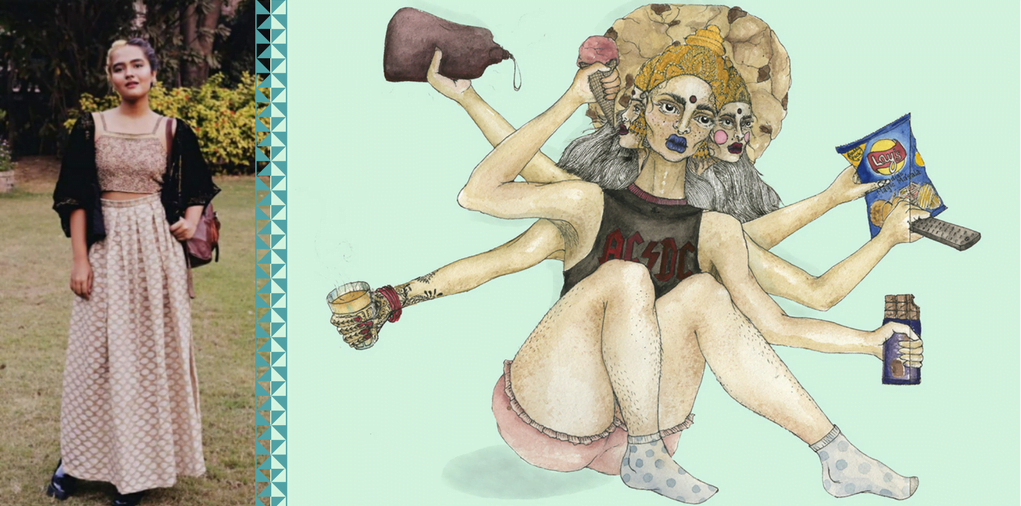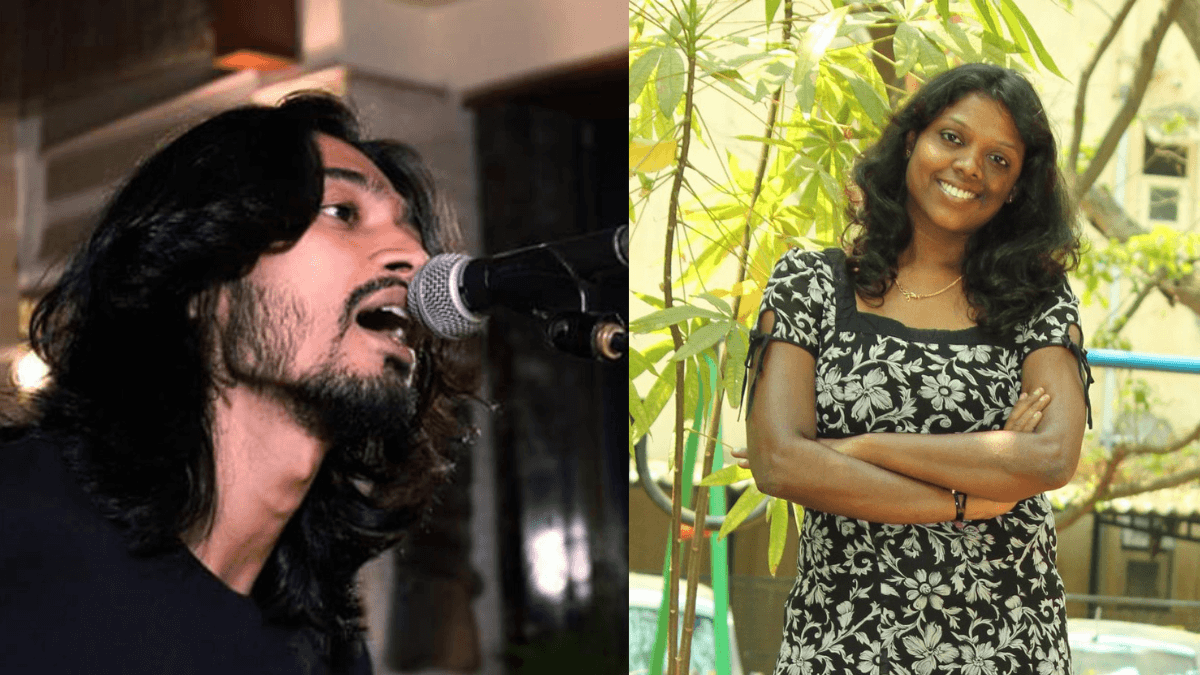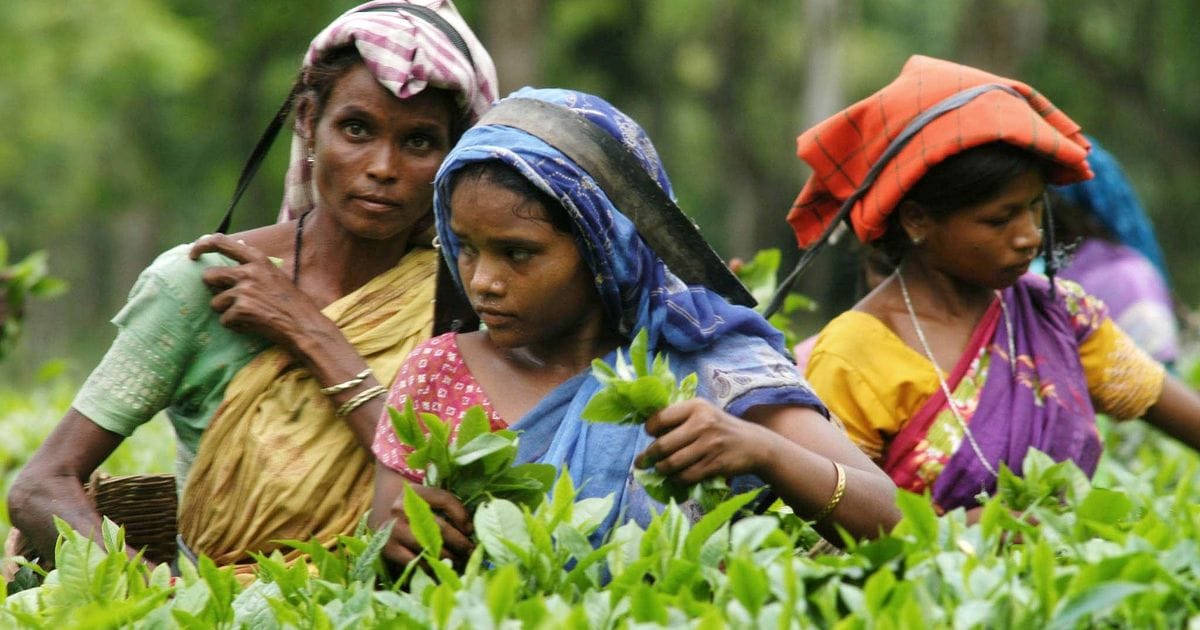Women’s bodies when portrayed by the media are almost inevitably sexualised, airbrushed and used to sell products – from cars to mango juice. There’s a crying need for body-positive visualisations of women, real women, and their real-life bodies and bodily processes – from menstruation to masturbation. This is where Sarah Naqvi and her wondrous Instagram page comes in.
Also Read: Menstruation in Media: Concealment and Celebration
Sarah Naqvi is a 20 year old textile artist who is currently in her third year at the National School of Design in Ahmedabad. She creates insightful, provocative, and creative works of art using different media – from paints to textiles – that exhibit the female form in all its glorious realness and mundanity.
https://www.instagram.com/p/BOqOfvQAT06/
We had the privilege of speaking with her about her patriarchy-smashing art and what spurs her on.
FII: You are famous for your body-positive, period-positive artwork. What spurred you into making body-positive art?
SN: Growing up in a fairly conservative society, the everyday sexism wasn’t uncommon for me. But what really made my blood boil was the indifference that I saw. We’ve been conditioned to believe that things are meant to be a certain way and that there are these roles assigned to each one of us. And that if you are to fit in, you must follow them blindly. But I really don’t buy it, I simply cannot believe in these roles and standards that have been forcefully fed to us by a society which is suffering from the effects of years of deep rooted patriarchy, which has created, cultivated and enforced an idea of the ‘ideal’ woman.
https://www.instagram.com/p/BNCpmDIgeYf/?taken-by=naqvi_sarah
I was privileged enough to have parents that stood by me, even when it was hard for them to fathom the consequences of my outspokenness. But the thought of just being a spectator and not being able to change what needs fixing gets me restless.
FII: You have moved from paintings to more textile-based art. What is your thought process behind your choice of medium?
SN: My work explores various mediums but the primary focus has always been on the needs and requirements of the concepts. So when I do start out with an artwork I usually follow a pattern which begins with ideating, research and making sketches, lots of sketches and random doodles till I land on something that really does justice to the message Im trying to convey.
https://www.instagram.com/p/BJu9A-2g_3X/?taken-by=naqvi_sarah
The reason why I make sure that I do all this preliminary work is because the topics I choose to work on are very close to me and those it connects to. These issues don’t exist in isolation and we are all part of their existence. We are all part of the problem and we also happen to be the solution. It’s just which one we choose to really be.
Most of my art uses the medium to start a dialogue, whether it provokes or just pleases. As long as it starts a conversation, it has made an impact. We have a history of shutting down the ideas we cannot comprehend, and the best way to change that is through opening ourselves to newer, more contemporary scenarios. It could be art, literature or even religion. If a subject that pulls together millions of different people spoke of these issues it would make the biggest difference.
https://www.instagram.com/p/BLGThhegIhe/?taken-by=naqvi_sarah
So with that hope I’m just trying to bring substance to art and not just beauty. The themes I work on are heavily inclined towards women empowerment, sexuality, and most importantly understanding the future that is at stake in trivialising these matters. I’ve been taught ever since I was a child to fight for what is right and speak up for anyone who has been kept quite for too long and for me that is what feminism really is. Its standing up for one another, because if a girl or guy in some part of the world is denied basic rights, its not just their battle, its ours.
https://www.instagram.com/p/BO9N-8NAfNg/?taken-by=naqvi_sarah
Embroidery is certainly one of my biggest strengths, especially with the issues I tend to work on. The fact that it has been tagged as ‘women’s work’ and that ‘it’s too girly a task’ with every stitch I make I hope that it challenges these common apperceptions and shows how much strength and voice every piece can carry.
https://www.instagram.com/p/BSi4rD0hP58/?taken-by=naqvi_sarah
FII: Why is it important to you to feature the female body in all its mundane glory?
SN: The female body has been the subject of objectification for so long now, that it is hard to see it as anything but a sexual symbol now. The more it has been altered and projected as perfect and slender, the more it gives rise to self-hate among women.
https://www.instagram.com/p/BPLS8zOAMDf/?taken-by=naqvi_sarah
The idea that in order to be beautiful you must have what the world accepts made me start what I call an acceptance revolution. The more we are exposed to a real biological figure/ sketch of a woman, the faster we can start calling out the standards that are set around us.
https://www.instagram.com/p/BS_Y5WuFLGM/?taken-by=naqvi_sarah
Acceptance is the first step to admiration, the curves, stretches, burns, and scars are all part of a story that is waiting to be told and I’m just a mere storyteller. My work aims to show what it really is to be comfortable in one’s own skin and that once you learn to love yourself, others will too. It really isn’t half as easy as it sounds, but that’s exactly why we need work and energy that reminds us of how wonderfully flawed we all are which is what makes us so human and beautiful.
https://www.instagram.com/p/BRGJ5rRDkrA/?taken-by=naqvi_sarah
My work began out of sheer need, disappointment and the realisation that one’s best work comes out of struggle. So in times where we cant even walk busy streets at night without having the fear that we wont make it back home safely, it only seems right to at least try and make things better.
It is unfathomable to me how something as normal and biological as menstruation can be turned into a subject of disgust. As if it wasn’t hard enough for us to shed blood for 7 days a month, we also have to hear you crib about it?
Every sanitary pad commercial in India adds to the stigma that surrounds menstruation and its high time we spoke of the unspoken. My work on ‘Embroidery on a Tampon’ and ‘The Stained Panty’ came from the constant depiction of periods as blue gel and liquid on pads in its commercials. Seriously, what are we, Smurfs?
https://www.instagram.com/p/BODGjqpgW-y/
https://www.instagram.com/p/BLs1oIqgbnH/?taken-by=naqvi_sarah
Demonising the natural needs of the body is not only stagnating our growth but it ruins our ability to adapt. From almost non existent sex education to centuries of myths surrounding menstruation and sexuality, we now live in an age of tolerance and acceptance where we must choose to celebrate diversity and open ourselves to the realities we have been running away from for so long now.
FII: What’s the response been like to your art, especially on social media? Have you had to face trolls or has it been mostly positive?
SN: Social media is one of the most powerful platforms an artist can have to reach out to different people from all over the world especially in this day and age. Plus, reaching people who aren’t exposed to these issues is everything, because they happen to play a major role in their prevalence.
It’s fairly easy to convey messages to someone who already understands these problems but its really remarkable if one can get through that part of the population that has turned their heads away from these matters that they find so shameful. The start of a conversation, whether good or bad, the exchange of ideas itself is enough to start a dialogue and make a difference.
https://www.instagram.com/p/BTYqqwNFmV6/?taken-by=naqvi_sarah
Once I started putting my work up on social media and other portals for people to view, it was quite the rollercoaster ride. There was immense support from so so many people and majority of the feedback and criticism was positive and constructive. That said, the backlash wasn’t that easy to handle. On multiple occasions I received threats and nasty comments from anonymous people, mostly via messages on Instagram.
https://www.instagram.com/p/BJ2aRsyANX-/?taken-by=naqvi_sarah
Interestingly enough a couple of my artworks were even taken down from Instagram for obstruction of community guidelines. This honestly, gave me even more incentive to work harder than ever because it proved my entire point! Its so hypocritical how it’s okay to have highly sexualized and altered images of women all over the site, but a biological form of a woman’s body (sketch) is considered obscene?!
https://www.instagram.com/p/BMPqZBxgTje/?taken-by=naqvi_sarah
FII thanks Sarah Naqvi for taking out the time to speak with us for this insightful interview about her passionate, rebellious, and deeply important work.
About the author(s)
Asmita is a Freelance Communications Consultant, and specialises in leading digital advocacy campaigns for social and gender justice issues. When not using social media for work, she uses social media for fun (and a healthy dash of existential despair).




